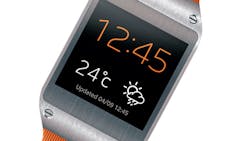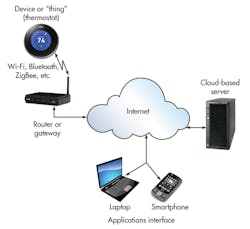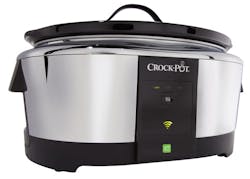The Internet of Things (IoT) and machine-to-machine (M2M) communications are hot technologies, dominating recent articles, blogs, conferences, and webinars. They won’t fully emerge this year, but great progress is being made in developing and deploying them (see “Who’s Doing What In IoT And M2M”).
M2M has been around for a while, but the IoT movement is still developing. Both technologies are looking for a few good applications, with several now on the market. The future will be more interesting when everything is connected.
This file type includes high resolution graphics and schematics when applicable.
IoT Versus M2M
M2M is the automated remote monitoring and control of objects, such as pipelines, vending machines, and trucks and fleet vehicles. It connects machines to one another and facilitates communications between them. This connectivity has largely been cellular, although other technologies like Wi-Fi are used.
M2M-enabled devices can exchange information, make decisions, and implement operations without human assistance. In development for more than two decades, M2M began with various applications in telemetry, industrial automation, and systems like SCADA (supervisory control and data acquisition).
M2M forms the basis for IoT. Also known as the Internet of Everything, IoT is a broader vision for connecting machines to machines or people to machines. While M2M focuses predominantly on industrial, business, and commercial applications, IoT is more for consumer applications.
The goal is to put almost anything on the Internet so it can communicate with remote computers, other devices, or even people. According to Juniper Research, “the management of devices is key to M2M and distinguishes it from the Internet of Things where any object may be furnished with connectivity on an ad hoc basis.”
The term “smart” is used to describe M2M and IoT devices and applications. The availability of Internet Protocol version 6 (IPv6) makes it possible connect billions of devices thanks to its 128-bit addresses. So why not?
There does not seem to be any formal definitions of IoT or M2M, and many people believe they are the same thing. One view is that M2M does not necessarily use the Internet, while IoT assumes an Internet path for communications. Both M2M and IoT are similar in their objectives but with slightly different applications and implementations. In any case, the two are similar.
Rejeev Kumar of Freescale calls IoT the technology of connecting any device with an embedded controller. Since virtually every electronic device has some kind of microcontroller, they all are candidates for an IoT application. Billions of devices are potential nodes on the Internet. Some sources expect 50 billion devices to be connected by 2020. Other estimates range from 20 billion to 100 billion connected devices by the 2018 to 2020 time frame.
The overriding goal of M2M and IoT is to add value. They aim to improve efficiency, cut costs, provide greater convenience, and improve customer service. When that can be demonstrated, they will be quickly adopted.
Just because we can do something technologically, though, it doesn’t necessarily mean that we should. Do we really need microwave ovens or toys connected to the Internet? The possibilities are endless, but common sense will prevail and practical applications will identify themselves.
How It Works
In IoT applications, the device to be monitored or controlled has an embedded wireless transceiver that talks to a gateway or router that has an Internet connection (Fig. 1). For example, a home thermostat would communicate by Wi-Fi with the home Wi-Fi router that connects to the Internet via a cable TV link. That link connects with a remote cloud-based server that supplies the application’s intelligence, collects the data, analyzes it, stores it, makes decisions, and initiates actions. This server connects by way of the Internet to the applications interface, where another machine like a PC analyzes and displays status and actions. Smartphones are popular interfaces, and they’re quickly becoming our all-purpose remote control.
An alternative scenario more fitting for an M2M application is a cellular telephone module embedded into the product to be monitored or controlled. The module talks directly to a nearby cell site through the standard cellular network. The cellular carrier routes the connection to the remote cloud-based server and the applications interface. In some cases, the application server may be a part of the cellular supplier’s service.
Most IoT and M2M applications are simple and not demanding, with modest data rates that do not require high-speed connections. Wi-Fi and 3G/4G cellular are usually overkill but are used anyway. A typical application may require only an 8-bit embedded controller. Communications connections like TCP/IP or UDP/IP and Ethernet, though, typically require a 32-bit processor including Linux or some smaller real-time operating system (RTOS).
The Wireless Technologies
The heart of most IoT and M2M products is one or more wireless connections. The technology chosen depends on the application and services available. Most short-range wireless technologies are used in some form, with cellular and Wi-Fi dominating.
M2M applications mostly use an embedded cellular radio. Multiple suppliers of cellular modules offer 2G, 3G, and 4G technologies. All the major cellular operators in the U.S. including AT&T, Sprint, T-Mobile, and Verizon offer M2M connectivity service.
GSM with GPRS 2G has been the most popular since it only involves low-speed data. But with most carriers phasing out 2G service or repurposing its spectrum in the coming years to better accommodate 3G and LTE services, the 2G option may be going away. Some carriers plan to phase out 2G by 2017, although others have no announced agenda for that.
For new applications, 3G like WCDMA or CDMA2000 is a better choice. Most M2M applications are fixed and typically will remain the same for years, so it is best to have a solid guarantee of service for the future. For video and other high-speed applications, fast 3G and LTE modules and services are available to handle speeds to many megabits per second as needed.
About 40% of M2M is cellular. ABI Research predicts that by 2018, nearly 60% of M2M will be cellular and most of the M2M revenue will come from carrier services. With the maturity and saturation of the cell-phone business in the U.S. and Western Europe, the carriers are looking for paths to increased growth. M2M seems to be that route.
Wi-Fi is also a major technology for both IoT and M2M. Multiple vendor modules offer 802.11a/b/g/n connectivity, mostly in the 2.4-GHz band. Multiple vendors also supply routers and gateways that feature Wi-Fi. A common configuration is a Wi-Fi router with an Ethernet connection to a cable or DSL modem. Another variant is a gateway that takes Wi-Fi on one side and a cellular connection on the other.
Wi-Fi dominates where power is readily available, such as home appliances. Most major appliance manufacturers have already embedded Wi-Fi into refrigerators, washing machines, and dryers to report usage and various physical characteristics such as wear and time of use. Some home thermostats use Wi-Fi as well.
Furthermore, many homes already have a Wi-Fi router and Internet connection, making connectivity fast and easy. Wi-Fi is also the choice if longer range is needed. Most Wi-Fi connections can be achieved at a range up to 100 meters depending on the environmental conditions, especially obstacles like walls or foliage.
When low power consumption is mandatory and shorter ranges and multiple devices are involved, other wireless technologies are better options. Bluetooth Low Energy (BLE) is emerging as a key player, especially in health/fitness and medical monitoring applications. BLE is also a popular choice for wearable technologies. Its very low power consumption and maximum 1-Mbit/s data rate fit almost all possible applications.
When multiple sensors must be monitored, wireless technologies like ZigBee are a good choice as they offer the mesh network topology that allows hundreds or even thousands of nodes to be monitored or controlled. Building automation is one area. So are home-area networks (HANs) where the utility’s smart electric meter can provide energy consumption data wirelessly. In industrial settings, other wireless mesh networks may make more sense, like Linear Technologies Dust Networks’ WirelessHART and ISA 100a. Z-Wave is also an option in some consumer applications.
And let’s not forget RFID. Some “things” may only require a cheap and simple connection that an RFID tag can provide. Near-field communications (NFC) is another choice. Both are very short-range technologies (less than a few feet), but some applications are perfectly useful within this range. In all cases, these short-range wireless devices typically require an intermediate gateway to collect the data and then connect to the Internet or a cellular carrier by another wired or wireless technology.
Cabling also can be used in some IoT or M2M applications if it is available. Dial-up telephone lines have been used with modems for M2M. Power-line communications (PLC) is another alternative where applicable. PLC is more viable than ever wherever ac power lines are a clear choice for the communications medium. Multiple PLC technologies are available, such as HomePlug, IEEE P1901, PRIME, and G3.
M2M Applications
M2M uses fall into several major vertical categories: transportation, energy, industrial, sales and payment, security, and healthcare.
Transportation includes automotive fleet management. Trucking companies can use M2M to monitor the location and status of their tractors and trailers. Any large asset can be tracked via an embedded GPS receiver. Trains and boats also use M2M to a lesser extent, but that may increase in the future. Most of these applications use cellular connections. Other automotive uses are emerging as well (see “The Connected Car”).
Energy applications are based on the Smart Grid. M2M is increasingly used to monitor electric generating facilities, substations, and related equipment. It is extensively used in wind and solar generation plants. M2M has also come to some neighborhoods to send utility meter data back to the utility. Smart meters in homes transmit electric or gas usage to a nearby concentrator hub using ZigBee or some other wireless technology. The concentrator then connects back to the utility via the cellular network or some other wireless method.
Industrial M2M is simply a variation of industrial automation communications. There are many forms of industrial networks, and the number of wireless networks is growing. Telemetry is the biggest category with the monitoring of oil and gas pipelines, tank farms, oil rigs, and other remote facilities by cellular or other connections.
Sales and payment uses are everywhere. Point-of-sale terminals are all networked, many wirelessly. Vending machines and kiosks are often monitored by cellular. M2M also is used for security applications, particularly video that’s recorded and sometimes monitored by a person. Cellular is the usual choice, although other wireless links are often involved. Healthcare applications mostly involve remote patient monitoring.
The Internet Of Things
IoT is like M2M, with a broader scope of applications. It is more commercial, but there is also an industrial IoT for more hardened and secure applications. For the most part, IoT assumes that each “thing,” which can be almost anything, has an IP address. It has been a good concept for years, but now it’s in the very early stages of development. Like all new technologies, it has started with proprietary products and systems but seems destined to develop where standards are available to move the concept forward to implementation.
Most applications target the home, such as the slow-cooking crockpot from Belkin’s WeMo family of IoT products (Fig. 2). You can turn it on and off and even control its temperature through an app on your iPhone. Other WeMo products include Smart LED lighting control and the WeMo Maker, a generic device that lets do-it-yourselfers build solutions by adding Internet connectivity to any device controlled with a dc switch such as robots, motors, and sprinklers via an iPhone app.
The Nest Learning Thermostat can replace most existing thermostats for improved monitoring and control of heating and air conditioning for energy savings (Fig. 3). It is linked by Wi-Fi to the home router. A smartphone app lets you view and change the setting. Google recently acquired Nest, which also offers IoT smoke and carbon-monoxide sensors for the home.
Note the theme here. A smartphone or a tablet is used as the monitor and control device. These are ideal platforms for Internet connections. That means more machine-to-human rather than machine-to-machine conversations, unlike pure M2M. And the number of possible home applications is huge. Besides appliances, IoT will include garage doors, door locks, security systems including remote video monitoring, lighting, and more.
However, home automation is still a niche. Not many households are willing to add all that technology with its high cost and management overhead. Too much tech support is required to get everything installed and working, and troubleshooting takes up lots of time. Few people want the hassle of programming and coordinating all the connected products.
The things in the Internet of Things only are connected so people can monitor and control them. They do not talk to one another. It doesn’t make sense for your crockpot to talk to your door lock, but such communications eventually can be implemented. Security systems can be connected to lighting systems, for instance. That’s the IoT of the future.
Health and fitness is another burgeoning IoT area. Patient monitoring has become popular with sensors like electrocardiogram patches, sleep sensors, blood glucose and blood pressure monitors, and thermometers for specific body functions. Patients can be quickly and easily instrumented with sensors and wireless connections that gather data for transmission later or even in real time.
Vignet’s hub collects data from wireless sensors using Bluetooth, Wi-Fi, or some other wireless link and stores and consolidates it (Fig. 4). Gemalto’s embedded Cinterion 3G/4G cellular module sends the collected data to the health care provider. Unlike other solutions on the market, this hub meets Health Insurance Portability and Accountability Act (HIPAA) privacy requirements, an important feature when dealing with personal medical data.
Wearable technologies are another IoT category, including Google Glass, smart watches such as Samsung’s Gear, and sensor-embedded clothing like vests and coats (Fig. 5). These devices usually connect via Bluetooth to a smartphone or other platform for further processing and connectivity. Fitness devices transmit exercise data like heart rate or pedometer steps from Bluetooth sensors to a smartphone for collection, storage, and analysis. The general acceptance of wearables has yet to be determined, but they definitely will be part of the IoT mix.
Critical Issues
Security, certification, and standards all are slowing full M2M and IoT adoption. For example, the Federal Communications Commission (FCC) must certify all wireless products. If you embed wireless chips into your product, you will need to comply with the Code of Federal Regulations (CFR) 47 Part 15. These regulations mostly involve tests to ensure proper power output and frequency as well as minimal electromagnetic interference (EMI) with other products and services. The finished unit must be tested and certified before you can use or sell it.
This is a huge issue if you aren’t an experienced wireless engineer. Most designers have a certified compliance test lab perform the testing, which can cost around $10,000. You can do some initial compliance testing yourself if you have a spectrum analyzer. Some newer oscilloscopes like Tektronix’s MDO4104B have a built-in spectrum analyzer that will let you check your own compliance (Fig. 6). Incidentally, if you embed pre-certified Wi-Fi or other wireless modules in your design, you won’t have to endure the compliance testing.
The lack of standards is impeding progress as well. The wireless standards are fixed, but the protocols for transferring data aren’t. Most products and systems use proprietary protocols. However, there are several efforts to develop some protocols that most devices can use. This will speed development and perhaps even make it possible for seamless interoperability among products. Standards have yet to be finalized, though. So if you’re planning an IoT product or business, take a close look at the alternatives and support the one that’s best for you.
The International Telecommunications Union (ITU) is working on M2M standards, but it will be a while before we see final ratification of this work. In the meantime, the Telecommunications Industry Association (TIA) TR-50 Smart Device Communication Standard now standardizes the link that smart devices use to communicate with services and applications. It provides an agnostic framework to allow all devices, routers, gateways, and other equipment to work together. The work is still in progress, but final results are expected this year.
Another major effort is the AllJoyn protocol developed by Qualcomm. Based on Linux, it is like an application programming interface (API) that lets devices talk to one another and provides a programming framework for development. Qualcomm recently transferred AllJoyn to the Linux Foundation, which created the AllSeen Alliance, a consortium of companies to support and further develop the standard.
Another protocol worthy of consideration for IoT is 6LoWPAN. This encapsulation and header compression standard developed by the Internet Engineering Task Force (IETF) allows IPv6 packets to be used with the IEEE 802.15.4 wireless standard. It supports mesh networking and is the basis for ZigBee and other short-range wireless standards. It also can enable the sensor-heavy IoT in low-power format.
IBM is promoting its own protocol called Message Queuing Telemetry Transport (MQTT). It has been around a few years and was originally developed for oil and gas distribution companies to monitor pipelines. It is a good fit for many IoT applications. Designed for low-power sensor applications, it already has heavy backing from the Organization for the Advancement of Structured Information Standards (OASIS), a consortium that promotes the development of open standards.
Security protects and defends information from unauthorized access, use, disclosure, modification, or destruction. It is a key issue in IoT and M2M, and the degree of its importance varies widely with the application. Most wireless and other technologies have incorporated encryption (such as AES 128) that provides the first step in protecting communications.
However, some applications such as industrial IoT may require more robust procedures. For example, device authentication may be needed in critical instances. Solutions include the use of virtual private networks (VPNs), multiprotocol label switching (MPLS), tunneling, Internet Protocol security (IPsec), standard security label (SSL), or firewalls. Security is far beyond the scope of this article, but you should be aware of its need as you develop any new products or services.
Finally, how will widespread IoT/M2M affect existing networks? Will the “big data” created in the cloud overwhelm the Internet or clog the cellular systems? Will the EMI from billions of wireless nodes overwhelm the spectrum? While most IoT and M2M applications only generate small bits of data usually at low speeds at low power, will the sheer volume of billions of connections simple bring our networks to their knees? We shall see.
About the Author

Lou Frenzel
Technical Contributing Editor
Lou Frenzel is a Contributing Technology Editor for Electronic Design Magazine where he writes articles and the blog Communique and other online material on the wireless, networking, and communications sectors. Lou interviews executives and engineers, attends conferences, and researches multiple areas. Lou has been writing in some capacity for ED since 2000.
Lou has 25+ years experience in the electronics industry as an engineer and manager. He has held VP level positions with Heathkit, McGraw Hill, and has 9 years of college teaching experience. Lou holds a bachelor’s degree from the University of Houston and a master’s degree from the University of Maryland. He is author of 28 books on computer and electronic subjects and lives in Bulverde, TX with his wife Joan. His website is www.loufrenzel.com.







